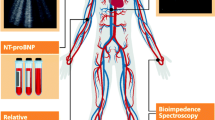Abstract
Cardiovascular disease is a leading cause of death in patients with chronic kidney disease. Recent evidence suggests that hypertension and subclinical volume expansion is common in patients on peritoneal dialysis. Moreover, recent studies pointed out that sodium removal is limited in patients on peritoneal dialysis and mortality has been shown to co-relate with fluid and sodium removal. Treatment of sodium and fluid removal includes dietary salt and fluid restriction, use of diuretics, icodextrin, strategies also considered helpful to control hypertension. Despite availability of these measures, prevalence of hypertension remains high in PD patients. Hence, innovative strategies are urgently required to address this common and difficult clinical problem. This article reviews limitations of available measures to manage sodium and fluid overload and hypertension and suggests possible role and place of low sodium dialysis solutions in PD patients.
Similar content being viewed by others
References
Paniagua R, Amato D, Vonesh E et al. Effect of increased peritoneal clearances on mortality rates in peritoneal dialysis: ADEMEX, a prospective, randomized controlled trial. J Am Soc Nephrol 2002; 13(5): 1307–1320.
Menon MK, Naimark DM, Bargman JM et al. Long term blood pressure control in a cohort of peritoneal dialysis patients and its association with residual renal function. Nephrol Dial Transplant 2001; 16: 2207–2213.
Gunal AI, Duman S. Strict volume control normalizes hypertension in peritoneal dialysis patients. Am J of Kidney Dis 2001; 37: 588–593.
Medcalf JF, Harris KPG, Walls J. Role of diuretics in the preservation of residual renal function in patients on continuous ambulatory peritoneal dialysis. Kidney Int 2001; (59): 1128–1123.
Woodrow G, Stables G, Oldroyd B et al. Comparison of icodextrin and glucose solutions for daytime dwell in automated peritoneal dialysis. Nephrol Dial. Transplant 1999; 14: 1530–1535.
Plum J, Gentile S, Verger C et al. Efficacy and safety of a 7.5% icodextrin peritoneal dialysis solution in patients treated with automated peritoneal dialysis. Am J Kid Dis 2002; 39: 862–871.
Konings CJ, Kooman JP, Schonck M et al. Effect of icodextrin on volume status, blood pressure, and echocardiographic parameters: A randomised study. Kidney International 2003; 63: 1556–1563.
Rodriguez-Carmona A, Fontan MP. Sodium removal inpatients undergoing CAPD and automated peritoneal dialysis. Perit Dial Int 2002; 6: 705–713.
Davies SJ, Woodrow G, Donovan K et al. Icodextrin improves the fluid status of peritoneal dialysis patients: Results of a double blind randomized controlled trial. J Am Soc of Nephrol 2003; 14: 2338–2344.
Cocchi R, Esposti ED, Fabbri A et al. Prevalence of hypertension in patients on peritoneal dialysis: results of an Italian multicentre study. Nephrol Dial Transplant 1999; 14: 1536–1540.
Koc M, Toprak A, Tezcan H et al. Uncontrolled hypertrension due to volume overload contributes to higher ventricular mass index in CAPD patients. Nephrol Dial Transplant 2002; 17: 1661–1666.
Oretega O, Gallar P. Peritoneal sodium mass removal in continuous ambulatory peritoneal dialysis and automated peritoneal dialysis: Influence of blood pressure control. Am J Nephrol 2001; 21: 189–193.
Ahearn DJ, Nolph KD. Controlled sodium removal with peritoneal dialysis. Trans Amer Soc Artif Organs 1972; 18: 423–429.
Khandelwal M, Kothari J, Krishnan et al. Volume expansion and sodium balance in peritoneal dialysis patients. Part II: Newer insights in management. Adv Perit Dial 2003; 19: 44–52.
Freida PH, Issad B. Impact of a low sodium dialysate on usual parameters of cardiovascular outcome of anuric patients during APD. (Abstract) Perit Dial Int 1998; 18.
Vande Walle J, Raes A, Castillo D et al. Advantages of HCO3 solution with low sodium concentration over standard lactate solutions for peritoneal dialysis. In: Khanna R, ed. Adv Perit Dial. Peritoneal Dialysis Publications 1997; 13: 179–182.
Author information
Authors and Affiliations
Rights and permissions
About this article
Cite this article
Khandelwal, M., Oreopoulos, D. Sodium and volume overload in peritoneal dialysis: limitations of current treatment and possible solutions. Int Urol Nephrol 36, 101–107 (2003). https://doi.org/10.1023/B:UROL.0000032699.91947.7f
Issue Date:
DOI: https://doi.org/10.1023/B:UROL.0000032699.91947.7f




